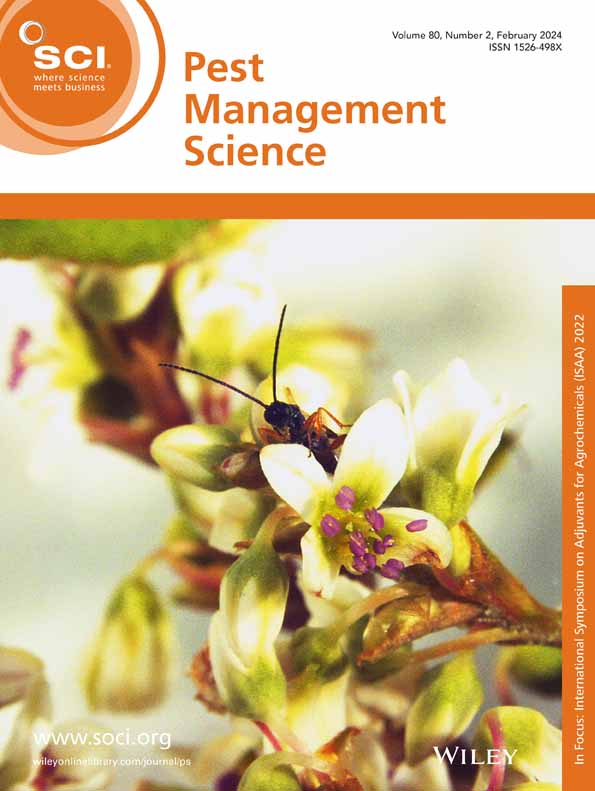番茄温室中荨麻疹叶螨、persimilphytoseius和pygmaus相互作用的研究:一个具有Beddington-DeAngelis响应的交叉扩散模型
IF 3.8
1区 农林科学
Q1 AGRONOMY
引用次数: 0
摘要
两斑蜘蛛螨(Tetranychus urticae Koch)对温室番茄生产构成重大威胁,可能造成≤40%的产量损失。尽管利用专门捕食者persimilis Phytoseiulus和通用捕食者pygmaeus进行生物控制在小规模研究中被证明是有效的,但它们在大型商业温室中的相互作用仍然知之甚少。本研究开发了一个结合空间动力学和多物种相互作用的数学模型,以将实验室研究结果与商业应用联系起来。结果该模型结合了扩散模式、植物防御和种内捕食对种群动态的预测效果最好(MSE分别为0.221和0.125)。空间扩散对模型精度的影响最大,而所有pygmaus诱导的影响在实践中都很小。该模型在3周内预测荨麻疹种群的方向精度达到77.2%。模拟结果表明,早施persimilis(每叶0.5株)可在4周内有效防治荨麻疹。结论本研究表明,在小规模实验中观察到的许多物种相互作用可能无法直接转化为商业环境中的有效生物防治,这可能是空间稀释的结果。我们进一步发现,空间运动大于实验室观察到的影响。最后,我们的模型能够提前3周预测荨麻疹种群,并为生物防治剂释放策略提供基于证据的指导,帮助种植者优化害虫管理决策。©2025化学工业协会。本文章由计算机程序翻译,如有差异,请以英文原文为准。
Study of the interactions between Tetranychus urticae, Phytoseiulus persimilis and Macrolophus pygmaeus in a tomato glasshouse: a cross‐diffusion model case study with Beddington–DeAngelis response
BACKGROUNDThe two‐spotted spider mite (TSSM), Tetranychus urticae Koch, poses a significant threat to greenhouse tomato production, potentially causing ≤40% yield loss. Although biological control using the specialist predator Phytoseiulus persimilis and generalist predator Macrolophus pygmaeus has proven effective in small‐scale studies, their interactions in large commercial glasshouses remain poorly understood. This study develops a mathematical model incorporating spatial dynamics and multispecies interactions to bridge laboratory findings with commercial applications.RESULTSOur model incorporating diffusion patterns, plant defense and intraguild predation best predicted population dynamics (MSE: 0.221, 0.125 for T. urtica e and P. persimilis , respectively). Spatial diffusion had the strongest impact on model accuracy, whereas all M. pygmaeus ‐induced effects were minimal in practice. The model achieved 77.2% directional accuracy in 3‐week forecasts for T. urticae populations. Simulations revealed that early releases of P. persimilis (0.5 individuals per leaf) could effectively control T. urticae within 4 weeks.CONCLUSIONThis study demonstrates that many species interactions observed in small‐scale experiments may not translate directly to effective biocontrol in commercial settings, which is likely to be a consequence of spatial dilution. We further found that spatial movements outweigh laboratory‐observed effects. Lastly, our model enables 3‐week advance predictions of T. urticae populations and provides evidence‐based guidance for biocontrol agent release strategies, helping growers optimize their pest management decisions. © 2025 Society of Chemical Industry.
求助全文
通过发布文献求助,成功后即可免费获取论文全文。
去求助
来源期刊

Pest Management Science
农林科学-昆虫学
CiteScore
7.90
自引率
9.80%
发文量
553
审稿时长
4.8 months
期刊介绍:
Pest Management Science is the international journal of research and development in crop protection and pest control. Since its launch in 1970, the journal has become the premier forum for papers on the discovery, application, and impact on the environment of products and strategies designed for pest management.
Published for SCI by John Wiley & Sons Ltd.
 求助内容:
求助内容: 应助结果提醒方式:
应助结果提醒方式:


